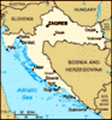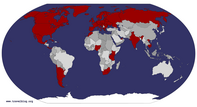Advertisement
Published: June 23rd 2020

 Cres Island
Cres Island
Largest Croatian islandIn a buffeting wind we drove along the sea coast to the historical city of
Pula. Our guide, Branca, rode in our bus for this first half of the day to give commentary and answer questions. Susan asked a series of good questions that informed us about high taxes: VAT at 25 per cent, income tax at 45 per cent, and property taxes, all of which pay for government services, war reconstruction, generous maternity leave, and good health care insurance. Housing costs are high because of demand and supply. Often university education is pursued in Italy, because it is closer than either Zadar or the capital, Zagreb.
In the back seat, Gary and Mici giggled over phone photos, conversing in an odd combination of German (Gary knows some, Mici is studying), English (Mici is good at guessing) and Hungarian, helped by Manka occasionally translating. Song broke out, including Jingle Bells, which most of joined for the chorus.
As we drove into Pula, glimpses of the Roman amphitheatre showed through Venetian palaces and Tito-era concrete apartment buildings. Branca explained that these Soviet style concrete buildings were not desirable as homes, but they did provide needed housing, unfortunately not inexpensively.

 Branca, our guide
Branca, our guide
Roman amphitheatre in PulaPula’s Roman amphitheatre is large, remarkably similar to the even bigger Roman Coliseum. Unlike in Rome, the whole of the perimeter walls and raked seating still exists. Part of the seating was roped off for fairly regular musical performances. In conserving the amphitheatre, a single section of the wall was cleaned to show how it must have looked when new. Rather than pressure-washing, laser cleaning is now the standard. Although all the detail is preserved, it is expensive. When I looked at the almost white section, I was glad they wouldn’t do any more, because the dirt of time does seem to add to our perception of antiquity. In the underground floor (where gladiators used to prepare) is a museum with displays of items found in the excavation. Piles of jars survived, either because their shape was strong or because an overwhelming number were used in everyday life.
Roman gates remain in the city. They had always functioned as markers of the town limits, not as defensive mechanisms, because Rome controlled the whole area. A little way on, Branca showed us a gate that was a Roman replacement of the original one, a commemoration of her soldier husband by

 Spectacular candy store
Spectacular candy store
Fresh versions of childhood candieshis widow. This brought us to the main street, where we walked on limestone highly polished by hundreds of years of foot traffic. Amongst the shops in the Venetian buildings was an astonishing candy story with candy in almost every imaginable shape. I fell into temptation with the fresh licorice-all-sorts – quite expensive at 2.5 euros per 100 grams but fun to eat. Seeing people gathered to look at something, I discovered it was a statue of
James Joyce who had worked in Pula. Last year I saw the statue in Dublin. Joyce must have been a striking personality because both statues portrayed the same brash panache.
We noticed that a few people were carrying olive branches from a Palm Sunday service. The flow increased, some people with small palm branches. As we approached the square with the cathedral, congregants were greeting and chatting in groups after the service. Some of us broke off from our group to look inside. Although the sanctuary was big, the design was very plain. Wonderfully, the choir was singing (perhaps a quick rehearsal). Their mixed voices resonated through the almost empty church. At a surprising speed, men were clearing up from the service and
closing down the church, regardless of the few tourists and the choral music.
Further along the Peninsula in Rovinj, we had lunch at the elegant Perla Restaurant in a modern grey décor. For tourists with more sites to see, the service was agonizingly slow. Soup orders were taken. After a time, a crostini plate was served to each of us. When it finally came, the fish soup was a delicious broth with tiny pieces of white fish. A long time later, great platters of mixed grill (pork chops, traditional sausages, veal skewer, mushrooms, red pepper and zucchini) were brought to the table. The portions were so large that Manka had ordered eight servings for eleven people, and still the quantity was excessive. To reduce the dessert offering, she had ordered some plates of mixed pastries to allow for tasting; three platters were brought out with four different pastries on each. Despite the groaning, everything was eaten!
To the patient chagrin of our guide, Branca, we displayed more interest in a movie being shot in Rovinj harbour than in the history of the town. Selma Hayek and Ryan Reynolds were filming The Hitman’s Wife’s Bodyguard in Croatia.

 Mixed grill, Perla Restaurant
Mixed grill, Perla Restaurant
Lamb, potatoes, pork chop, onions, sausages, eggplant with ajvar (red pepper) sauceBlack speed boats raced across the same bit of water several times in the tedious repetition of filming action movies.
Entering the old town walls, at last we started appreciating the medieval streets with their well-cared-for homes. Flowers bloomed in window boxes, a bright accent as we toiled up the steep cobbled street. St Euphemia’s Church was built on the site of older church and used to be dedicated to St George. Now a statue of
St Euphemia stands on top of the bell tower, as a wind vane . She was an early Christian, martyred by the Romans. The statue showed her with a wheel, because she was tortured, and a lion, because the lions wouldn’t eat her when she was thrown to them, although wounds from a bear did cause her death. Inside, the Baroque design drew attention to the main altar and side altars. Intricate 6 century mosaics were highlighted by gold. By the main altar was a gruesome mural of St Euphemia being martyred in an amphitheatre in front of cheering crowds and overseen by cherubs. The complex was quiet, inviting contemplation of the icons and religious themes above the congregation.
Definitely behind schedule, we

 St Euphemia's trial by lions
St Euphemia's trial by lions
The lions refused to attack her, evidence of her holiness.dawdled down to the seafront and gawked at the speedboats. A sudden explosion startled our hearts! A fishing boat in the harbour had exploded! Except it hadn’t – the boat was intact. Devices in the boat spewed flame and heavy dark smoke, and speed boats rushed back and forth. No one had their camera out in time to capture it.
The seafront market offered innumerable products made of olive oil, truffle oil and honey. The similarity of the displays on the tables made us wonder if one company owned all of it. Even so, those who wanted truffle oil got their bargain.
Driving inland to Porec, flatter land with olive farms and vineyards took over from the mixed forests closer to the coast. We passed a number of cyclists dressed in their sports gear. Tomas was making good speed, as he liked to, when roadworks at a crossroads concerned him. He pulled off a bit and waited for the other bus; he, Paul and our guide Branca discussed the route, which led through the roadworks area. Other cars were mounting a curb, bouncing along on some wasteland beside the uncompleted work. We did too. Thanks to the directions
freely offered by a local, Tomas navigated through narrow but charming streets of a completely residential area, bringing us out to the main road (not very big) and on to Porec.
The Euphrasian Basilica is a marvel, in this region of magnificent and significant buildings. Its history of construction and modification dates from the 5 century to the 19 century. The baptistry and large mosaic floor are the oldest parts. Glittering Byzantine mosaics express the reverence through time for the Christian story. The few tourists inside hardly detracted from the essential silence.
Returning to Lovran on the main highway, Tomas pointed out to me the communications tower on Mount Ucka, shining in the late afternoon sun as clouds lifted away from the top. This was yesterday’s unattainable goal. We lost sight of it as we drove through a 5 km tunnel to emerge into the trees and flowers of the sea coast.
From the hotel, we walked a short distance to a special sharing dinner in a popular restaurant. Since it was spring, wild asparagus was on menus everywhere. The soup was made by whizzing vegetables and the hard, lower stems of the asparagus into a smooth
base, finished with short pieces of the tops. The wild asparagus had a slightly bitter taste and none of the fleshy texture of our usual asparagus. The sharing plates of appetizers contained octopus salad (lemon dressing), black risotto made with squid ink, mussels, and the family’s favourite scrambled eggs. The dinner platters contained only fish: grilled sardines, grilled mackerel, fried calamari, breaded shrimps, plus a plate of steamed small squid in a natural sauce. For dessert, two servings of chocolate crepes sufficed for the whole table. In my last chance to taste a Croatian beer, I was happy to find local amber beer excellent.
Advertisement


























Isabel Gibson
non-member comment
I gained a pound . . .
. . just reading about your meals. :-) Even if you were set down blindfolded, you'd never mistake it for a North American offering, would you? I'm glad your intrepid group was up to the pastry challenge. The range of history you saw is amazing, form the defensive walls and churches through to the Yugoslav-era buildings (some with interesting angles - or are those later renovations?) and, of course, the movie filming. Quite a day. Quite a spot.